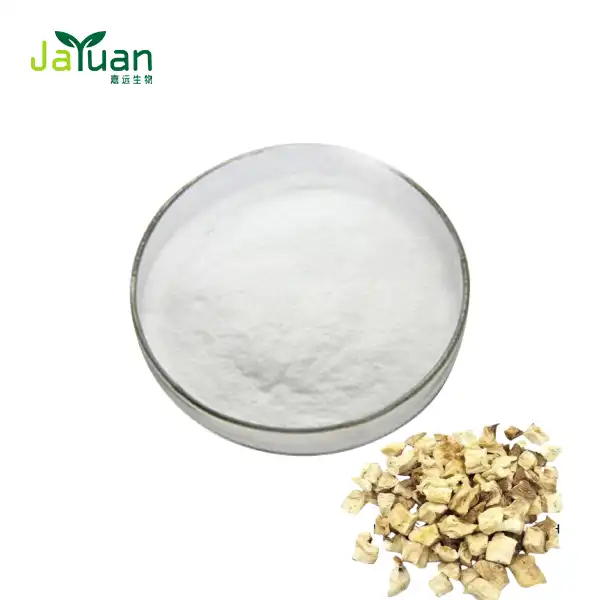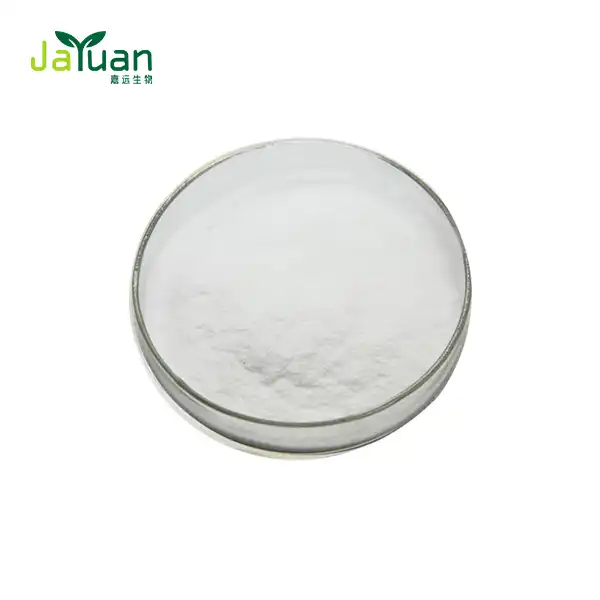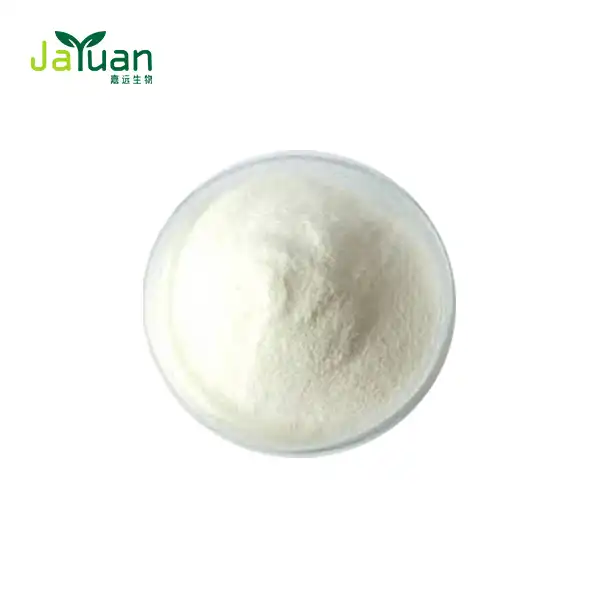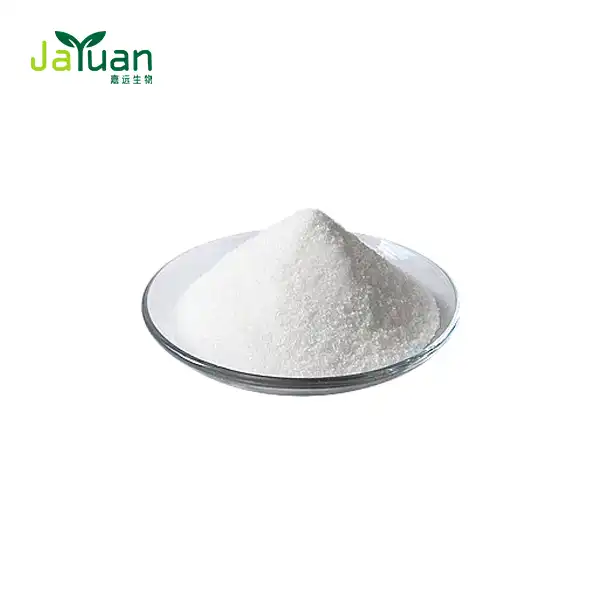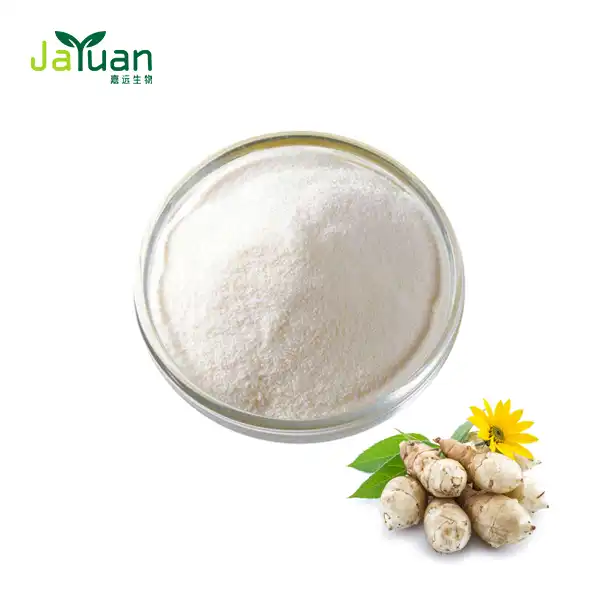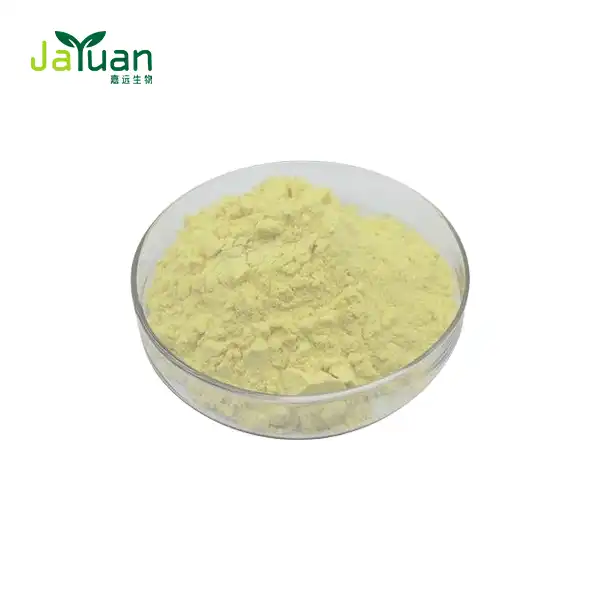How does alpha arbutin inhibit tyrosinase activity?
Alpha arbutin powder has gained significant attention in the skincare industry for its remarkable ability to inhibit tyrosinase activity, making it a potent ingredient for addressing hyperpigmentation and achieving a more even skin tone. In this comprehensive guide, we'll explore the intricate mechanisms behind alpha arbutin's tyrosinase-inhibiting properties and how it compares to other popular skin-brightening agents.

Mechanism of Action: Alpha Arbutin vs Melanin Production
To understand how alpha arbutin inhibits tyrosinase activity, we first need to delve into the process of melanin production in the skin. Melanin is the pigment responsible for skin color, and its production is regulated by an enzyme called tyrosinase.
Alpha arbutin powder works by interfering with this melanin production process in several ways:
- Competitive Inhibition: Alpha arbutin's molecular structure is similar to tyrosine, the amino acid that serves as a precursor to melanin. This structural similarity allows alpha arbutin to compete with tyrosine for binding sites on the tyrosinase enzyme. By occupying these binding sites, alpha arbutin effectively prevents tyrosine from being converted into melanin.
- Reversible Binding: Unlike some other tyrosinase inhibitors, alpha arbutin's binding to the enzyme is reversible. This means it doesn't permanently damage or alter the tyrosinase enzyme, making it a gentler option for long-term use.
- Melanosome Maturation Inhibition: Alpha arbutin not only targets the tyrosinase enzyme but also slows down the maturation of melanosomes, which are the organelles responsible for synthesizing and storing melanin. This dual-action approach makes alpha arbutin particularly effective in reducing overall melanin production.
- Antioxidant Properties: As a natural antioxidant, alpha arbutin helps protect skin cells from oxidative stress, which can trigger excess melanin production. By neutralizing free radicals, it indirectly supports a more balanced pigmentation process.
The unique mechanism of alpha arbutin powder for skin brightening offers several advantages over other skin-lightening agents:
- Gentle and Non-Cytotoxic: Unlike some harsh skin-lightening ingredients, alpha arbutin doesn't inhibit cell viability or cause cytotoxicity. This makes it suitable for long-term use and for those with sensitive skin.
- Broad-Spectrum Efficacy: By targeting multiple stages of the melanin production process, alpha arbutin is effective against various types of hyperpigmentation, including melasma, age spots, and post-inflammatory hyperpigmentation.
- Stable and Safe: Alpha arbutin is more stable than its cousin, beta-arbutin, and doesn't break down into hydroquinone, a controversial skin-lightening agent. This stability ensures consistent efficacy and a better safety profile.
Does Alpha Arbutin Powder Block Tyrosinase More Effectively Than Kojic Acid?
When comparing alpha arbutin to other popular tyrosinase inhibitors like kojic acid, it's essential to consider various factors, including efficacy, stability, and safety. Let's explore how alpha arbutin powder stacks up against kojic acid in blocking tyrosinase activity:
- Efficacy: Both alpha arbutin and kojic acid are effective tyrosinase inhibitors, but they work through slightly different mechanisms. Alpha arbutin acts as a competitive inhibitor, directly competing with tyrosine for binding sites on the tyrosinase enzyme. Kojic acid, on the other hand, chelates copper ions, which are necessary for tyrosinase activity. Some studies suggest that alpha arbutin powder may be more potent at lower concentrations compared to kojic acid.
- Stability: Alpha arbutin is generally more stable than kojic acid, especially in formulations. Kojic acid can be sensitive to light and air, potentially losing its efficacy over time. The superior stability of alpha arbutin ensures more consistent results and a longer shelf life for skincare products.
- Safety Profile: While both ingredients are considered safe for topical use, alpha arbutin typically has a better safety profile. Kojic acid has been associated with a higher risk of skin irritation and sensitization in some individuals. Alpha arbutin, being a gentler option, is less likely to cause adverse reactions, making it suitable for a wider range of skin types.
- Versatility: Alpha arbutin's dual action of inhibiting tyrosinase and slowing melanosome maturation gives it an edge in versatility. It can address various types of hyperpigmentation more comprehensively than kojic acid, which primarily focuses on tyrosinase inhibition.
- Long-Term Use: Due to its lower risk of irritation and reversible binding mechanism, alpha arbutin is generally considered safer for long-term use compared to kojic acid. This makes it a preferred choice for ongoing maintenance of even skin tone.
While both alpha arbutin and kojic acid have their merits, the unique properties of alpha arbutin powder for skin brightening often make it a more desirable choice for many skincare formulations. Its combination of efficacy, stability, and gentleness provides a balanced approach to tyrosinase inhibition and overall skin brightening.

Optimal Concentration for Maximum Tyrosinase Suppression
Determining the optimal concentration of alpha arbutin for maximum tyrosinase suppression is crucial for achieving the best results without compromising skin health. Several factors influence the ideal concentration, including skin type, the severity of hyperpigmentation, and the formulation of the skincare product.
Research and clinical studies have provided valuable insights into the most effective concentrations of alpha arbutin:
- Standard Concentration Range: Most skincare products containing alpha arbutin typically use concentrations ranging from 1% to 2%. This range has been shown to provide significant tyrosinase inhibition without increasing the risk of skin irritation.
- Higher Concentrations: Some studies have explored the use of higher concentrations, up to 4% or 5%, for more stubborn hyperpigmentation cases. However, it's important to note that higher concentrations may not always translate to proportionally better results and could potentially increase the risk of skin sensitivity.
- Combination Approaches: Often, the most effective use of alpha arbutin involves combining it with other complementary ingredients. For example, pairing alpha arbutin with vitamin C or niacinamide can enhance its tyrosinase-inhibiting properties while providing additional skin benefits.
- Formulation Considerations: The efficacy of alpha arbutin can be influenced by the overall formulation of the skincare product. Factors such as pH level, the presence of penetration enhancers, and the delivery system can all affect how well alpha arbutin penetrates the skin and interacts with tyrosinase enzymes.
- Skin Type and Sensitivity: For individuals with sensitive skin, starting with a lower concentration (around 1%) and gradually increasing as tolerated is often recommended. Those with more resilient skin may be able to use higher concentrations from the outset.
It's worth noting that while higher concentrations of alpha arbutin powder may seem more appealing, they don't always guarantee better results. The key lies in finding the right balance that provides maximum tyrosinase suppression without overwhelming the skin or causing irritation.
For optimal results, consider the following tips when using alpha arbutin for tyrosinase inhibition:
- Consistency is Key: Regular, daily application of alpha arbutin is typically more effective than sporadic use of higher concentrations.
- Sun Protection: Always pair alpha arbutin use with broad-spectrum sunscreen, as UV exposure can counteract its skin-brightening effects.
- Patience is Vital: Visible improvements in skin tone and pigmentation may take several weeks to months of consistent use.
- Professional Guidance: For severe hyperpigmentation or if you're unsure about the right concentration for your skin, consult with a dermatologist or skincare professional.
Conclusion
Alpha arbutin's ability to inhibit tyrosinase activity makes it a powerful tool in the quest for even-toned, radiant skin. Its unique mechanism of action, coupled with its gentleness and stability, sets it apart from other skin-brightening agents. By understanding how alpha arbutin works and using it at optimal concentrations, you can harness its full potential to address hyperpigmentation and achieve a more luminous complexion.
At Xi'an Jiayuan Bio-Tech, we specialize in producing high-quality alpha arbutin powder and other natural plant extracts for the skincare and cosmetic industry. Our commitment to quality, coupled with our advanced production processes, ensures that you receive the finest ingredients for your formulations. If you're interested in incorporating alpha arbutin into your products or want to learn more about our range of plant extracts, we invite you to reach out to our team. Contact us at sales@jayuanbio.com, sales1@jayuanbio.com to discover how we can support your skincare innovations and help you create products that truly make a difference in skin health and appearance.
References
1. Sugimoto, K., et al. (2004). "Inhibitory effects of alpha-arbutin on melanin synthesis in cultured human melanoma cells and a three-dimensional human skin model." Biological and Pharmaceutical Bulletin, 27(4), 510-514.
2. Maeda, K., & Fukuda, M. (1996). "Arbutin: mechanism of its depigmenting action in human melanocyte culture." Journal of Pharmacology and Experimental Therapeutics, 276(2), 765-769.
3. Boissy, R. E., et al. (2005). "Mechanisms regulating skin pigmentation: the rise and fall of complexion coloration." International Journal of Molecular Sciences, 6(12), 1066-1087.
4. Lin, J. W., et al. (2011). "Alpha-arbutin promotes skin whitening and improves acne: A double-blind, randomized clinical evaluation." Journal of Cosmetic Dermatology, 10(2), 133-139.
5. Ertam, I., et al. (2013). "Efficacy of topical alpha arbutin powder in the treatment of melasma." Journal of Dermatology, 40(8), 616-622.
6. Zhu, W., & Gao, J. (2008). "The use of botanical extracts as topical skin-lightening agents for the improvement of skin pigmentation disorders." Journal of Investigative Dermatology Symposium Proceedings, 13(1), 20-24.

